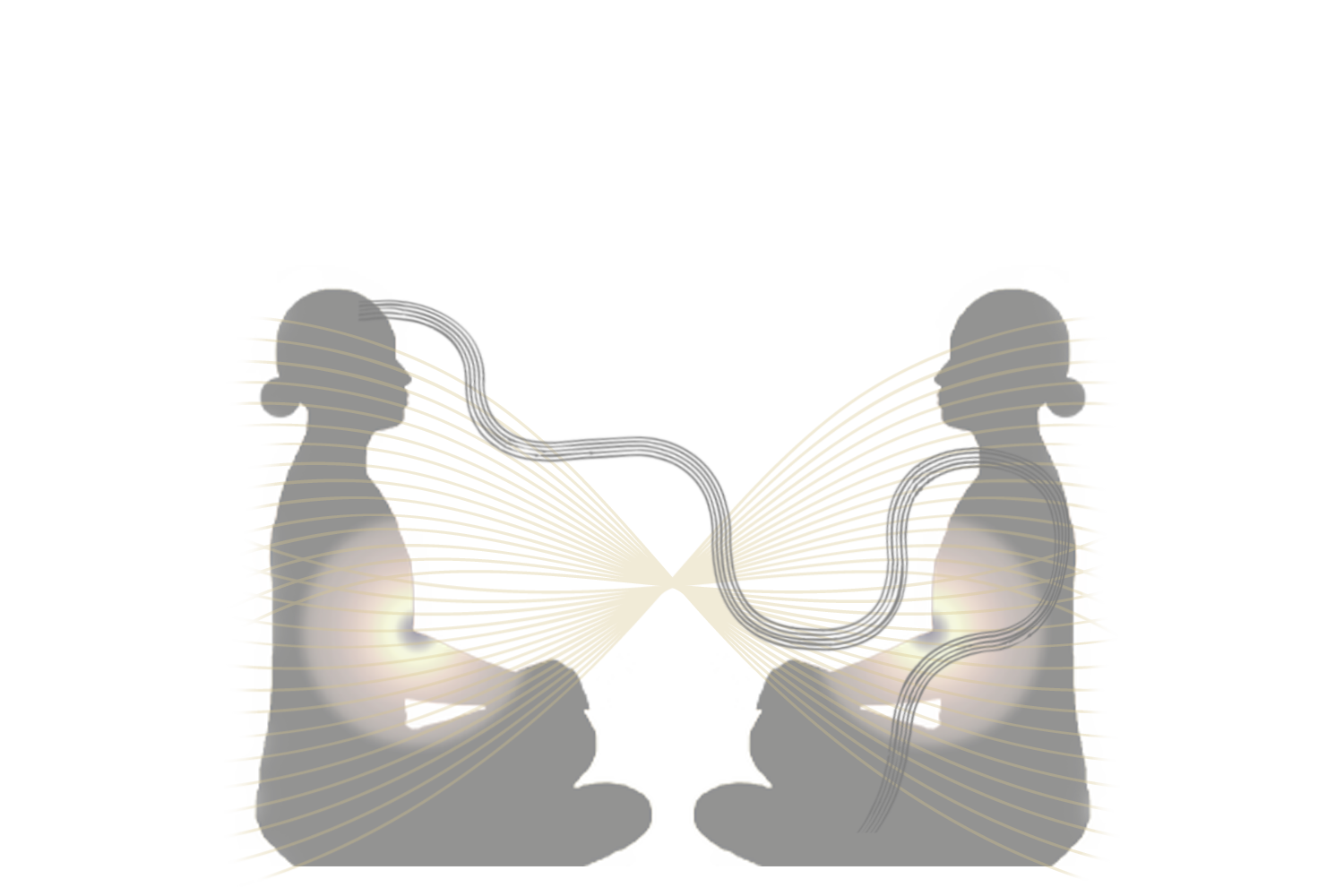The Science

The Invisible Space Around Us
We are all connected. Not just in a philosophical sense, but physically, quite literally, connected. My atoms touch your atoms. The atoms in you vibrate against the atoms in the elements—air, water, earth, fire—which vibrate against the atoms in me, in her, in him, in them, in those. In all of us and all things. It has to do with the quantum field, magnetism and the invisible space around us.Essentially, the electromagnetic force that’s created from and between subatomic particles, atoms, molecules, and bodies—a human being, a Monstera plant, a Banyan tree, a tulip, an octopus, a beagle, a panda, a bacterium, a malachite crystal, a beach pebble, everything— travels through the quantum field. The field can be thought of as the space between atoms in you and atoms in me. An invisible but potent space. Like a drop that makes a ripple in a pond, or a musical note played on a violin, or a blue light from a cell phone screen, those waves of energy travel through space over a period of time, however minute, to connect us all in a living blanket of experience. The energy of experience—thoughts, emotions, sensations, intentions, meditation—travels through this fabric of existence so that we are all connected to one another and feel each other’s experiences, if even imperceptibly.
With the development of electromagnetism in the nineteenth century, the concept of fields began to take shape—how two objects interact with one another is through ‘space-filling lines of force.’ Like how gravity exerts force from one body to another. The force, in effect, travels through space along distinct lines and at a distinct speed—the speed of light. An example of this can be seen when sprinkling iron filings on a sheet of paper over a bar magnet. The curved lines of the magnetic field can be seen over the magnet.
Each subatomic particle (protons, electrons) absorbs and emits electromagnetic radiation— exerting electromagnetic force—and this force, or energy, travels through the quantum field. The particle exudes force because it is always moving. Similar to how you would expend energy just from walking in place. The subatomic particle has a distinct location in space and time only once someone observes or measures it. The particle is everywhere and nowhere.
Though these lines of energy are invisible to the naked human eye, they still exist. Outside of a physics lab, we, as humans, can tell of their existence through the effect of these energy flows on our mind, body, and spirit—from the atomic and subatomic levels to the holistic level. Ever meet someone and feel and think, ‘wow, they had such good energy?’ The vibrations of their atoms ‘felt good’ to the vibrations of your atoms. The vibrations of both of your atoms, your energies, were in sync, aligned. It’s like how certain music resonates with your deepest parts while others don’t.
Meditation
At its core, meditation is a mindfulness or awareness of your present moment, your internal and external landscapes. As with anything, meditation included, one generally gets better with practice. It takes a lot of brushstrokes or camera shutter releases to get to that one prized piece of art, a lot of sentences and crafting to write a piece of classic literature. Practicing meditation helps an individual body as a whole, as one system. Among others, research has shown the effectiveness of meditation in reducing blood pressure and heart rate, irritable bowel syndrome, stress, anxiety, depression, and insomnia, in altering levels of melatonin and serotonin, and in boosting immune response, promoting positive mood states and enhancing self-esteem.
Meditation also helps at the neurological, brain chemistry level. Some research shows that meditation can physically change the brain, its processes, and activity, especially over time. Brain imaging techniques have shown that meditation, over just several weeks, can change how different parts of the brain communicate with each other. This in turn changes our thoughts and emotions, further changing how the brain functions, and creates a positive feedback loop. Research has also shown that, in the brains of expert meditators, their anterior cingulate cortex associated with the unpleasantness of pain—and parts of the prefrontal cortex had halted communication between each other. Participants still felt the pain but their thoughts about the pain changed—they interpreted it as less painful.
Practicing meditation helps promote higher-order brain functioning by strengthening the prefrontal cortex in the brain—associated with functions like awareness, concentration, and decision-making—and weakening the amygdala—associated with fear, emotion, and stress response. Your brain uses high-level processing to supplant low-level responses.
Giving and Receiving
Research on receiving positive energetic intent, or prayer of blessing, in other words, has shown positive effects even in double-blind studies. A Duke University Medical Center study found that the cohort with the highest success rate was a subgroup of cardiac patients who received intercessory prayer as part of their post-operative therapy treatment. Another double-blind study at San Francisco General Hospital’s Coronary Care Unit found similar results for those patients that were sent healing thoughts.
Studies have also shown that just the perception of someone setting or having good intentions for you has positive benefits. One study involved the perception of pleasure, pain, and taste and found that candy tasted better and sweeter, pain from electric shocks hurt less, and chair massages felt more pleasurable when participants thought these had good intentions behind them. The effect is even stronger when there are actual positive intentions set by one person for another.
Multiple double-blind, randomized controlled trials have shown benefits to patients receiving healing thoughts, and these are amplified when sent from a group. The collective power of positive healing intention is exponentially better than the powerful individual positive energetic intention from one person to another.
Other studies have also shown that practicing loving-kindness meditation, or giving positive intention, for others strengthens not only our own compassion for others but also our willingness to act to help relieve others’ suffering. This positive intention or meditation for others lessens activity in the giver’s amygdala while simultaneously activating parts of the brain associated with love and good feelings. Another study found that mindfulness or meditation practice activates the brain’s left anterior insula/inferior frontal gyrus, involved in empathy and emotional regulation. Other research also suggests that it can also reduce our judgmental attitude toward others and improve conflict resolution.
Synchronizing Minds and Long-distance Healing
Positive intention can be measured by how it affects other entities. In this way, positive intention can be thought of as traveling through a quantum magnetic field.
Because we are all connected through the quantum field, the power of sending positive energetic intention is not only possible but effective. Particularly as more individuals join together in sending these positive intentions, their minds and brain activity synchronizes, strengthening as they form a collective whose whole is larger than the sum of its parts. The intention is magnified simply because it is complemented by others. With such a powerful collective, enlarged force of directed positivity, it is even easier for it to travel long physical distances through the quantum field and element of space.
Much of the scientific research on brain activity involving more than one person is still relatively new, mostly done in the last couple of decades or so, and primarily because the science and technology tools and techniques were simply not yet sophisticated enough. This type of brain imaging research is now called hyperscanning and its techniques include separate functional magnetic resonance imaging (fMRI), electroencephalography (EEG), magnetoencephalography and functional near-infrared spectroscopy. This field of interactive social neuroscience is nascent but quickly growing. Researchers are starting to capture what happens in our brains when engaging with one or more persons, or as a group, through studies examining eye contact, storytelling, joint focused attention, or other tasks requiring social interaction and exchange.
Studies on joint attention found that the brain regions, such as the temporal parietal junction, associated with thinking about the mental states of others (mentalizing) reacted differently when sharing attention with others than when observing something alone. Research studying storytelling between two people has also shown how participants’ brains synchronize and become more alike.
“Your brain as an individual is really determined by the brains you’re connected to,” said Uri Hasson, a neuroscientist with Princeton University, in a 2019 interview with Scientific American.
Further, the closer you feel to someone, or the more you like them, the more your brains synchronize and align. Other studies have proven how the brains and brain waves in a group synchronize when engaging in shared activities like meditation, concerts or movies.
Research studies have also shown statistically significant treatment effects and positive outcomes for distance healing, such as facilitating implantation and pregnancy for infertile women treated with in vitro fertilization.
Some scientists argue that some of the effects of distance healing and mind-body synchronization has to do with quantum entanglement. The theory suggests that once two subatomic particles have interacted, even if they’re separated by long distances, they forever behave as if they’re still connected. It’s been demonstrated in varying degrees in research studies between people in close relationships—couples, siblings, parents and children.
Quantum physics also surmises that subatomic particles can be in two places at once. The 2012 Nobel Prize in Physics was won by two scientists who each measured this. In terms of distance healing, quantum physics helps explain how the healing practitioner can use their thoughts and intentions in one location to direct the energy of the particles in the recipient at the same time, even a world away.
Whether we use positive intention focused on healing ourselves or others, the power we hold to harness the force that binds us all is omnipresent and indispensable.
Try the Seeds App for FREE

